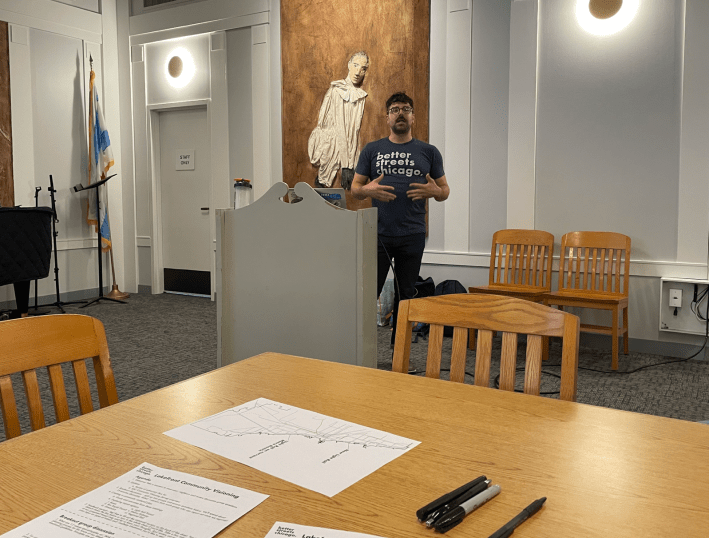
Last month, hundreds of sustainable transportation advocates, and many local elected officials, gathered outside Truman College in Uptown for the Save our Lakefront Rally. Meanwhile, inside the building, the Illinois and Chicago departments of transportation, were holding a presentation for the current Redefine the Drive plan, which would rebuild North DuSable Lake Shore Drive basically as-is. As you can see from the images above, some of the renderings show larger beaches and more green space, but a more car-centric coast.

The protestors demanded that the agencies instead adopt a more walk/bike/transit-friendly approach. And after the demonstration, it was a crowded house at the open house, as participants filled the large room to share their POVs with the transportation staffers.

But an IDOT official claimed that, even if Governor JB Pritzker and Mayor Brandon Johnson, who control the agencies, wanted to convert two of the eight mixed-traffic lanes on NDLSD to bus-only, it wouldn't be practical to do so. That dubious explanation suggests that proposals to convert the drive into a more compact, human-friendly surface-level boulevard are completely off the table.
Fortunately, the grassroots advocacy group Better Streets Chicago, which helped organize the rally, doesn't see it that way, and they're continuing to lead the charge for a less car-centric lakefront. This week they held a Lakefront Community Visioning Meeting at the Sulzer Library in Lincoln Square. "We'll discuss the community visioning work we've been up to, and get your input and ideas on what our lakefront could look like without a highway!" the invite said.
Better Streets Policy Director Micheal Podgers led the discussion at the meeting, the first of its kind. "We are starting our process of trying to do a community-centered and a community-led alternative planning process," he explained during the introduction. "We want to identify what kind of design for DuSable Lake Shore Drive... what transportation options and roadway design options residents really want. And then also start to figure out what are some of the other things that aren't transportation-related that we should be thinking about and integrating into this project."

Podgers emphasized that the DOTs need to realize that Redefine the Drive is not just a transportation project, but also an environmental, parks, and urban development project. "So there's a lot happening simultaneously, and one of our concerns is that those other details are kind of getting washed away," he said.
At the meeting, Better Streets released the results of its recent survey on the future of the shoreline and DuSable Lake Shore Drive, which had over 2,000 participants. Here are the results:
- 73% of respondents said DLSD diminishes the quality of the parks.
- 52% reported having at least one car and wanting to give it up.
- 34% reported having no car.
- 70% said they want to drive less than they currently do.
- 55% reported they want to bike more than they currently do.
At one point during the meeting, the attendees split off into breakout groups to discuss three questions. These were, "What one to three values and principles should we prioritize?" "What is the most important outcome to rebuilding DLSD?" and "What improvements or changes are important to you?"

After attendees returned from their individual discussions, Better Streets Executive Director Kyle Lucas was the first person to share what his group discussed. "In terms of some of our personal priorities for the outcome of rebuilding DLSD, we were talking about accessibility, both in terms of accessing the lakefront, but also thinking about folks with disabilities and their engagement with the Drive," he said. "It's about creating community agency and freedom, really giving people choices in how they can get around, and ensuring that that's reflective of their desires and needs. And then ensuring that there's better transit, better bus lanes, or ensuring that there's connectivity across the lakefront in a variety of ways."

Toward the end of the meeting, Podgers went over all the transit options that DLSD could potentially have: bus, bus rapid transit, streetcar, light rail, metro/subway (i.e. the 'L'), or regional/commuter rail (i.e. Metra). He also reviewed the different options for what DLSD could look like, including an expressway, highway, parkway, road, boulevard, or "depaving" it entirely.

Attendees were invited to put a sticker by which transit mode and roadway (or lack thereof) they would like. Adrian Lehmann said he wants to see "somewhere between a parkway and a boulevard... [a] fairly low-speed and low-danger-to-cross street design, focused on providing access to the park, instead of cutting off access from the park."
Lehmann added that, while the likelihood of winning people-friendly designs for NDLSD may depend on how ambitious the proposals are. "I do think there's reason for optimism," Lehmann. "If it can be communicated correctly, a lot of residents will be on board with this, and a large coalition can be formed to build this, especially because the money is there right now. [There are] billions of dollars allocated."

Did you appreciate this post? Please consider making a tax-deductible donation, to help keep Streetsblog Chicago's sustainable transportation news and advocacy articles paywall-free.





